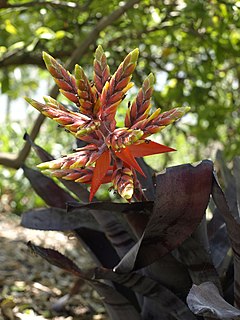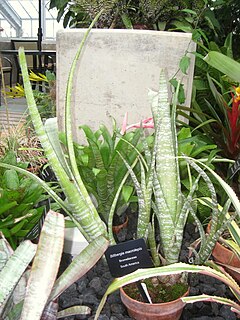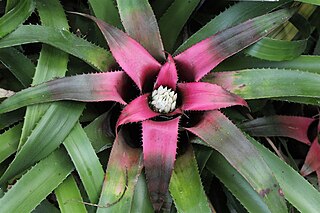Related Research Articles

Billbergia is a genus of flowering plants in the family Bromeliaceae, subfamily Bromelioideae. The genus, named for the Swedish botanist, zoologist, and anatomist Gustaf Johan Billberg, is divided into two subgenera: Billbergia and Helicodea. They are native to forest and scrub, up to an altitude of 1,700 m (5,577 ft), in southern Mexico, the West Indies, Central America and South America, with many species endemic to Brazil.

Aechmea angustifolia is a plant species in the genus Aechmea. This species is native to Central America and northern South America.
Aechmea cucullata is a plant species in the genus Aechmea. This species is native to Colombia and Ecuador.
Aechmea hoppii is a plant species in the genus Aechmea. This species is native to Colombia, Ecuador and Peru.
Aechmea moorei is a plant species in the genus Aechmea. This species is native to Ecuador and Peru.

Aechmea nidularioides is a plant species in the genus Aechmea. This species is native to Colombia, Ecuador, and Peru.

Aechmea penduliflora is a species of flowering plant in the Bromeliaceae family. It is native to Central America and northern South America.

Aechmea retusa is a plant species in the genus Aechmea. This species is native to Ecuador, Colombia and Peru.

Aechmea tessmannii is a plant species in the genus Aechmea. This species is native to Ecuador, Peru, and Colombia.

Aechmea zebrina is a plant species in the genus Aechmea. This species is native to Ecuador and Colombia; it is relatively common in the lowland Amazon region of eastern Ecuador and southern Colombia.

Billbergia macrolepis is a species in the genus Billbergia. This species is native to Costa Rica, Panama, Colombia, Ecuador, Venezuela, and Guyana.
Billbergia stenopetala is a species in the genus Billbergia. This species is native to Ecuador and Peru.
Guzmania danielii is a plant species in the genus Guzmania. This species is native to Bolivia and Ecuador.
Guzmania donnellsmithii is a plant species in the genus Guzmania. This species is native to Costa Rica, Panama, Nicaragua, and Ecuador.

Guzmania eduardi is a plant species in the genus Guzmania. This species is native to Ecuador and Colombia.

Neoregelia pendula is a plant species in the genus Neoregelia. This species is native to Ecuador.

Pitcairnia maidifolia is a plant species in the genus Pitcairnia. This species is native to Central America and northern South America.
Vriesea zamorensis is a plant species in the genus Vriesea. This species is endemic to Ecuador.
Tillandsia floribunda is a species in the genus Tillandsia. This species is native to Ecuador.
Tillandsia secunda is a species in the genus Tillandsia. This species is native to Ecuador.
References
- 1 2 Kew World Checklist of Selected Plant Families
- ↑ Luther, H.E. (1999). "Bromeliaceae". In Jørgensen, P.M.; León-Yánez, S. (eds.). Catalogue of the vascular plants of Ecuador = Catálogo de las plantas vasculares del Ecuador (PDF). St. Louis, Mo.: Missouri Botanical Garden Press. pp. 337–361. ISBN 978-0915279609. Archived from the original (PDF) on 26 September 2006.
- ↑ BSI Cultivar Registry Archived 2009-12-02 at the Wayback Machine Retrieved 11 October 2009